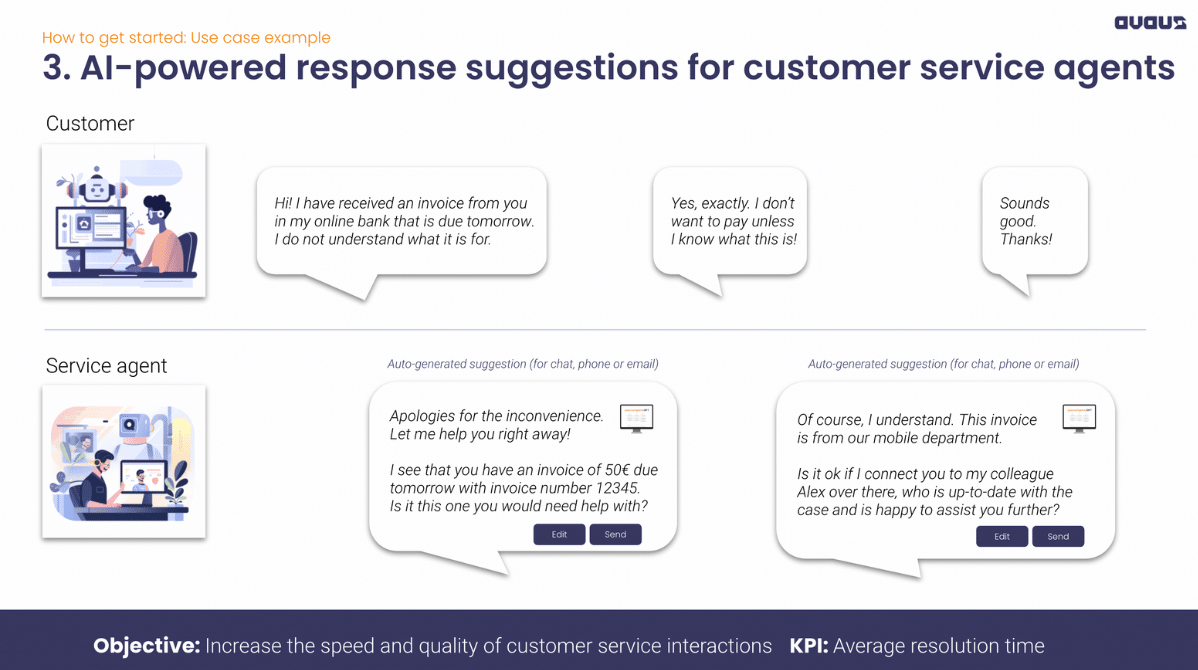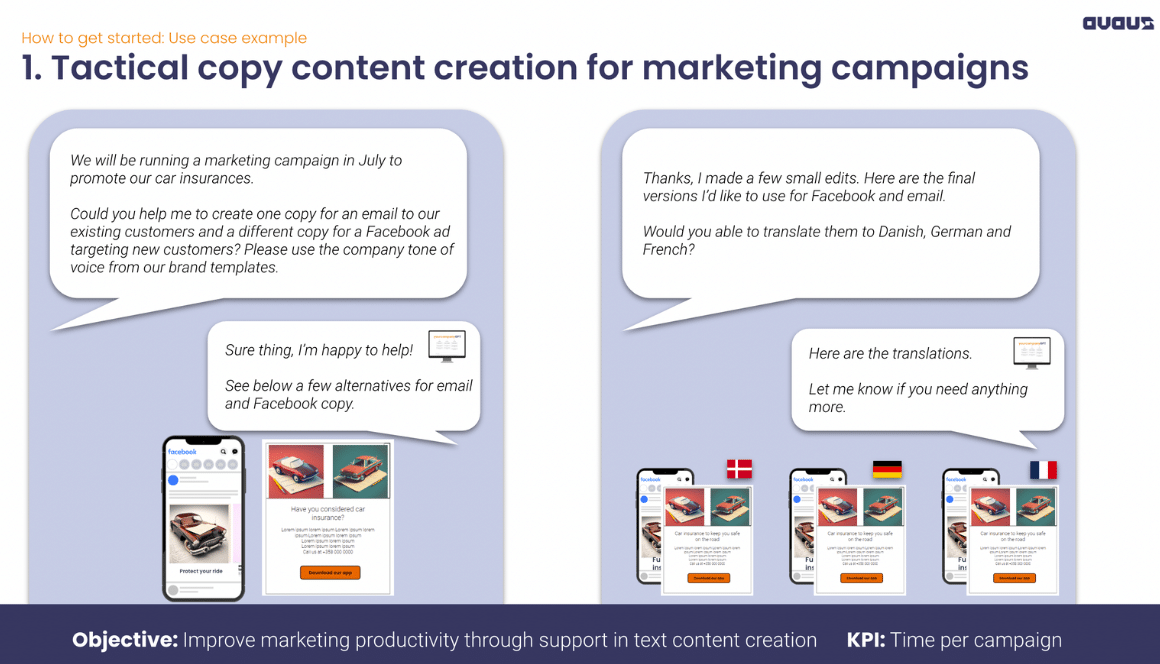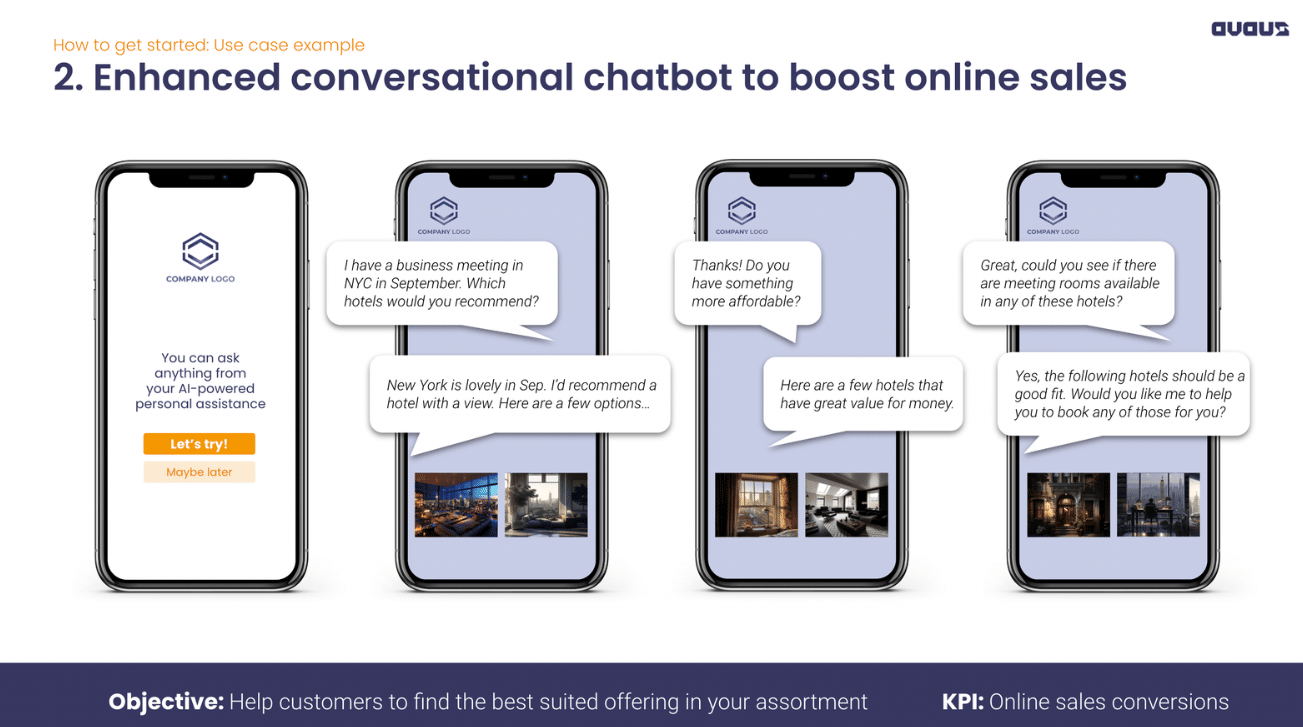Are you a business leader navigating Generative AI? Look no further. This is your ultimate guide.
Generative AI has vast potential for businesses, especially in marketing, sales, and service. Advanced models like ChatGPT, DALL-E, and Midjourney are driving the possibilities of generative AI. Here’s what they do:
- ChatGPT: Powers chatbots and virtual assistants with human-like text for personalised experiences and automated conversations.
- DALL-E: Generates realistic images from textual descriptions, benefiting industries like e-commerce, advertising, and design.
- Midjourney: Facilitates data generation and manipulation for data augmentation and content creation.
To explore the potential of generative AI for your business, this guide offers valuable insights and practical advice tailored to business leaders. Let’s dive into the business potential of Generative AI.
What can Generative AI do for your business?
Generative AI can help you boost productivity and save costs. Here are some key benefits of adopting this technology:
- Increased efficiency. Streamline processes and save time by automating tasks.
- Informed decision-making. Make smarter choices by analysing data-driven recommendations that drive your business forward.
- Personalised experiences. Automate complex tasks and processes, freeing up your team to focus on strategic initiatives.
- Advanced automation. Automate complex tasks and processes, freeing up your team to focus on strategic initiatives and higher-value work.
- Seamless content creation. Generate product descriptions, marketing materials, and more with ease.
- Unleash your team’s creativity. Use Generative AI as a powerful tool for brainstorming ideas and exploring new creative possibilities.
1. Take the lead as a business leader!
As a business leader, it’s crucial to be fully involved in AI adoption. Bring the entire management team along on the journey to unlock the full potential of AI. By leading AI investments, you align AI initiatives with your business goals and set clear expectations. With your guidance, AI becomes a strategic tool to drive growth, enhance efficiency, and gain a competitive edge.
“When businesses fail to effectively articulate their needs, they miss out on unlocking their true potential.” – Emma Storbacka, CEO at Avaus.
Why should you get your whole organisation on board with you?
When you involve your entire organisation in AI adoption you can tap into diverse perspectives and expertise. This promotes a culture of continuous improvement and adaptation. Leaving Generative AI solely to the IT department limits its transformative impact on marketing, sales, and customer service. Take ownership of AI implementation to inspire your organisation, drive innovation, and stay ahead of the competition.
“The real challenge lies in scaling up AI to unlock its full potential and achieve tangible business value. It’s important to recognize that the IT department alone cannot drive this transformation.” – Eldar Terzic, CTO at Avaus.
Balance innovation and responsibility
Address ethical and compliance considerations as you implement Generative AI. Stay up-to-date with ethical standards and ensure compliance with regulatory requirements to maintain trust and responsible AI adoption.
2. Generative AI is transforming work as we know it
Generative AI is revolutionising work across all functions of an organisation, with unparalleled productivity gains. Studies on writers and programmers consistently show significant productivity increases of 35% to 50% with the integration of AI. This surpasses historical gains achieved through steam power in the mid-1800s.
Generative AI allows you to achieve more in less time, freeing employees from repetitive tasks and enhancing performance and job satisfaction. Adaptation to generative AI can make your business stand out and drive productivity growth.
3. Prioritising High-impact Use Cases for Generative AI: A Strategic Approach
To fully leverage Generative AI, identify high-impact use cases based on value, feasibility, and risk. Evaluate the following:
- Value: Determine areas where Generative AI enhances customer engagement, optimises content creation, and automates repetitive tasks.
- Feasibility: Assess infrastructure readiness, scalability requirements, and technical expertise for successful implementation.
- Risk: Address stakeholder impact, privacy and security concerns, compliance and copyright requirements, and mitigate biases for responsible AI adoption.
By prioritising high-impact use cases and following a strategic approach, harness Generative AI’s capabilities for transformative business outcomes. Assess value, feasibility, and risks to ensure focused and successful implementation.
4. Prioritising Business Areas: Start with Marketing, Sales and Service
When determining where to focus your efforts, it’s wise to begin with customer-facing functions such as marketing, sales, and service. But why prioritise these areas over IT, legal, and finance?
Here’s the reason: Marketing, sales, and service offer unique advantages, including easy implementation, high return on investment, and quick payback times. By starting with these functions, you can reap significant benefits while managing the implementation effectively.
Now, let’s delve into how generative AI can take these key business areas to new heights:
Marketing – Amplify your reach and impact
Generative AI revolutionises content creation, automating tasks like crafting compelling copy and generating captivating visuals. It grabs audience attention and elevates the overall impact of your marketing efforts.
Sales – Streamline communication and boost efficiency
Generative AI streamlines sales processes by automating outbound messages and producing personalised proposals. It optimises sales strategies, improving communication efficiency and enhancing overall performance.
Service – Enhance customer satisfaction and support
Generative AI saves valuable time by generating suggested email responses and categorising call reasons. This ensures prompt and personalised customer interactions, resulting in heightened satisfaction and efficient support.
5. How to get started? Begin with a Proof of Concept
To implement Generative AI in your organisation, start with a Proof of Concept (PoC). This hands-on demonstration allows you to assess feasibility, showcase capabilities, upskill teams, and remove AI adoption stigma. Running a PoC builds a foundation for integration and boosts marketing process efficiency.
Putting Generative AI to the Test: Conducting a Hands-on Proof of Concept
Generative AI unleashes productivity and creativity in marketing, leading to innovative campaigns and captivating content. By running a PoC, you can harness generative AI’s benefits and integrate it successfully. This practical exploration helps acquire valuable skills, address concerns, and create a positive environment for generative AI integration.
Using Generative AI in Marketing:
- Marketing Copy: Auto-generate compelling and persuasive content for campaigns, saving time and resources.
- Visual Content: Create visually captivating marketing assets that resonate with your audience.
- Martech Journey Designs: Automate the creation of customer journey maps, empowering your team to focus on strategy and creativity.
Using Generative AI in Sales:
- Outbound Sales Messages: Automate outbound sales messages for easier outreach and personalised content.
- Customer Proposals: Quickly generate tailored proposals that showcase unique value and save time.
- Conversational Chatbot Enhancement: Enhance chatbot interactions with AI-generated responses for seamless and personalised experiences.
Using Generative AI in Service:
- Suggested Email Responses: Auto-generate suggested email replies for timely and accurate customer service.
- Call Reason Classifications: Automatically categorise incoming calls for efficient call routing and improved support workflows.
- Enhanced Customer-Facing Chatbots: Transform chatbots into intelligent virtual assistants for engaging customer experiences and reduced workload.
- Incorporating generative AI automates tasks, improves accuracy, and enhances customer interactions in service operations.
Image: Generative AI use case example in marketing.
Image: Generative AI use case example in sales.

Image: Generative AI use case example in service.
If you’re eager to learn more about how to get started and how we can support your organisation in adopting generative AI, continue reading.
6. Harnessing the Value of Classic AI: A Brief History & Integration
Classic AI offers businesses the ability to make better decisions and allocate resources effectively, driving growth. While it doesn’t generate original content like generative AI, classic AI provides a range of valuable applications. Let’s explore its history and how it can be integrated into your business strategies.
A Brief History of Artificial Intelligence
The captivating history of artificial intelligence began in the early 20th century, inspired by visionaries like Alan Turing. The concept emerged that machines could solve problems and make decisions using available information and reasoning, similar to humans. This laid the foundation for AI research.
The Dartmouth Summer Research Project: A Turning Point for AI
In 1956, the Dartmouth Summer Research Project on Artificial Intelligence (DSRPAI) brought significant breakthroughs. Mathematicians and scientists explored how machines could use language and think like humans, propelling two decades of AI advancements.
A Rollercoaster of Progress and Setbacks
From 1957 to 1974, AI computers became faster and more accessible, and researchers made headway in machine learning algorithms. Despite setbacks, such as limited computing power, AI research experienced a resurgence with projects like Japan’s Fifth Generation Computer Project, influencing global awareness and interest.
The transition to modern AI: building on classic foundations
Modern AI has built upon the solid foundation of classic AI, with advancements in algorithms, specialised hardware, and powerful APIs. This transformational progress has significant implications for businesses.
Combining Classic and Generative AI for business advantage
Businesses can leverage both classic AI and generative AI. The integration of established techniques rooted in predefined rules and reasoning, along with the creative capabilities of generative AI, empowers businesses to automate tasks, personalise experiences, and explore innovative content generation.
Classic AI in Marketing, Sales, and Service
Classic AI plays a vital role in various business functions:
Classic AI in Marketing:
- Automated optimization decisions: Simplify marketing strategies by automating tasks like campaign scheduling, budget allocation, and targeting, leading to better marketing outcomes and increased customer engagement.
- Personalised communication: Use classic AI techniques to analyse customer data and deliver tailored marketing messages, providing targeted content across different channels and enhancing customer experiences.
Classic AI in Sales:
- Resource allocation optimization: Optimise sales resources such as sales representatives, territories, and leads using classic AI algorithms, resulting in higher productivity, efficiency, and improved customer engagement.
- Personalised offers and pricing: Analyse customer data and market dynamics with classic AI to personalise offers and pricing strategies, tailoring product recommendations and pricing structures to individual customers, driving higher conversion rates and satisfaction.
Classic AI in Service:
- Call deflection: Implement classic AI-powered chatbots and virtual assistants to handle common customer inquiries, reducing call volumes and waiting times while allowing staff to focus on complex needs.
- Next-best offers/next-best actions: Use classic AI algorithms to analyse customer data and predict suitable cross-sell, upsell, or recommended actions for each customer, providing personalised and timely recommendations to enhance the customer experience and maximise revenue opportunities.
Scaling Classic AI:
To fully unlock the potential of classic AI and maximise its value, organisations should:
- Embrace external partnerships and expertise: Collaborating with external partners brings fresh perspectives and specialised knowledge, accelerating the scaling of classic AI use cases.
- Clearly define goals and objectives: Align AI initiatives with strategic business outcomes, focusing efforts on areas with the most significant impact on growth and success.
- Invest in change management and training: Implementing classic AI at scale requires comprehensive change management and training programs, fostering a culture of AI adoption and equipping employees with the necessary skills and mindset.
By integrating classic AI into your business strategies and embracing its value alongside generative AI, you can optimise marketing, sales, and service functions while driving growth, personalising customer experiences, and unlocking new avenues for innovation and success.
7. Prioritise activities and allocate budget for Generative and Classic AI
To achieve sustainable results in both Generative and Classic AI, it’s crucial to systematically develop and scale your use cases. Here’s an approach to help you:
- Size the value and set targets. Understand the potential value AI can bring to your organisation and define clear objectives for success.
- Plan your use cases effectively. Prioritise short-term and long-term initiatives based on their impact and alignment with your business objectives.
- Operationalise and scale your AI use cases. Treat the implementation process like a factory, focusing on systematic scaling. Measure the impact on top-line and bottom-line performance. Emphasise process and progress management for continuous improvement and measurable outcomes.
Still not sure where to start?
If you’re unsure where to start, a PoC can be beneficial. Being an early adopter can provide a competitive advantage. Our team can help you de-risk the process and accelerate time to value.
During a 6-8 week period, our collaborative efforts will enable you to:
- Gain a deep understanding of the possibilities and opportunities presented by Generative AI.
- Engage key stakeholders from different parts of your organisation for alignment and buy-in.
- Identify specific areas where Generative AI can deliver tangible value.
- Conduct a PoC and establish a customised “yourcompanyGPT” model.
- Develop a practical and actionable plan for successful implementation and utilisation of AI.
By following these steps, you can effectively prioritise activities, allocate the budget, and make the most of both Generative and Classic AI in your organisation.
Related readings:
Read more about how we can help your organisation move forward with generative AI: https://www.avaus.com/generative-ai/
Read more about our own GPT: https://www.avaus.com/press-release/2023-04-25-avaus-announces-avausgpt-with-purpose-to-supercharge-consultancy-deliveries/
Read the CMO’s guide to generative AI: https://www.avaus.com/news/the-cmos-guide-to-generative-ai-why-you-should-care/
Read how to catapult your marketing productivity with generative AI: https://www.avaus.com/news/catapult-your-marketing-productivity-with-generative-ai-a-step-by-step-plan/
Read why you need domain specific co-pilots on your AI journey: https://www.avaus.com/blog/why-you-need-domain-specific-co-pilots-on-your-ai-journey/
Watch a video about unlocking business value from customer data using AI and automation: https://youtu.be/WOfIyQYSxqQ
Read more about ten prompting techniques to future-proof your career: https://www.avaus.com/news/how-to-talk-to-ai-10-prompting-techniques-to-level-up-your-career/
References:
Anyoha, R. (2017). The History of Artificial Intelligence. Retrieved from [Link]
McCorduck, Pamela (2004), Machines Who Think: A Personal Inquiry Into the History and Prospects of Artificial Intelligence (2nd ed.) pp.161–170.
Overview to the Fifth Generation Computer System project https://dl.acm.org/doi/pdf/10.1145/1067651.801682
Contact us

